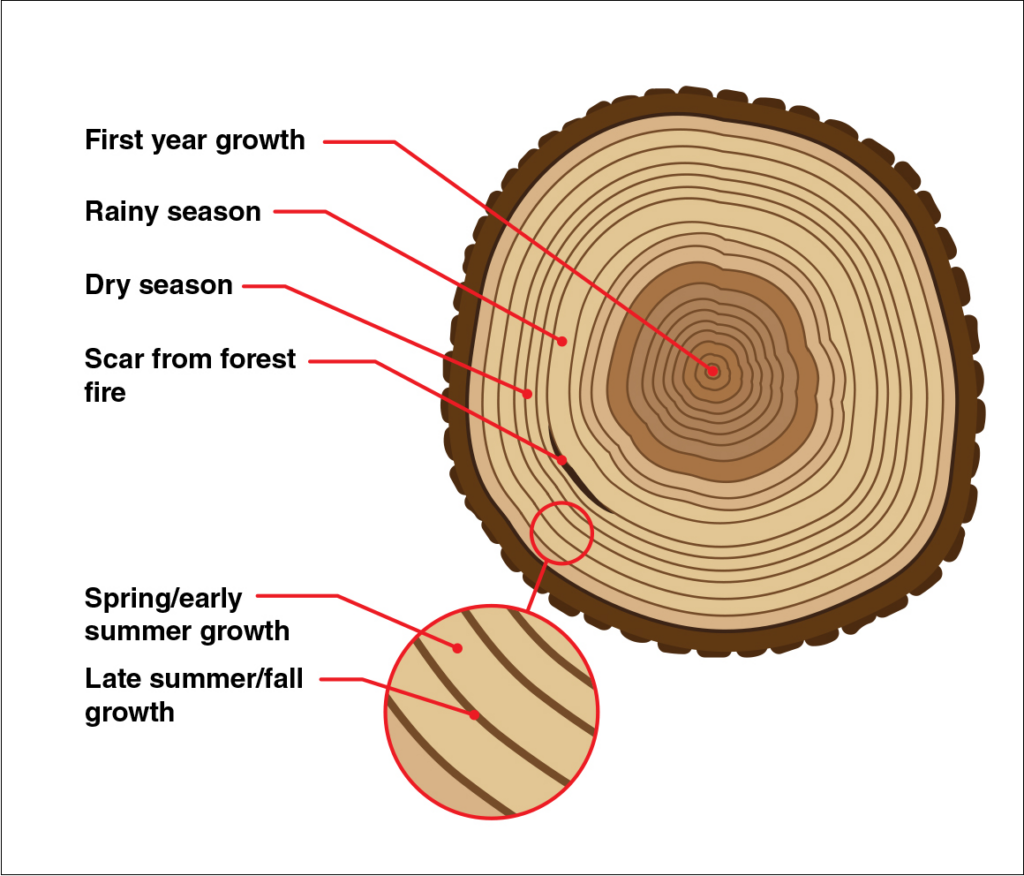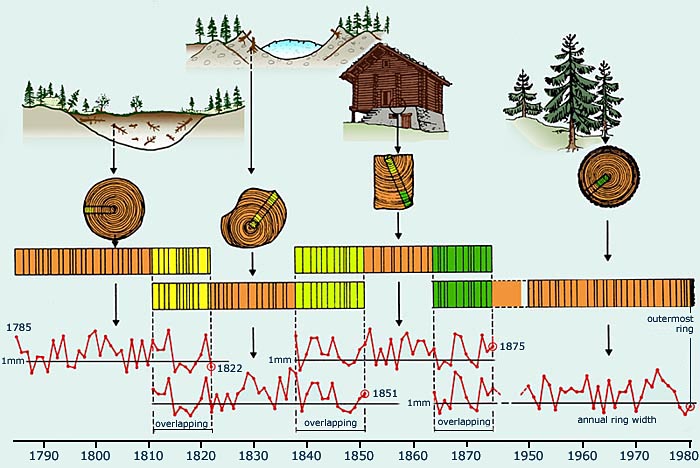Margo Gramiak
Most people are familiar with the concept that in a cross section of a tree, one ring is equivalent to one year of the tree’s life. What most people don’t know is how much more each tree ring can tell us.
Beyond just age, each individual tree ring holds knowledge of past climate. Because one year is represented by one ring, the condition of each ring can indicate what the climate was like at the specific time of its formation (Neural Academy 2018). Exploring this concept is a form of dendrochronology, which directly applies to paleoclimatology, the study of past climates (Neural Academy 2018). Our climate records only go back 150 years, and the practice of dendrochronology allows us to fill in gaps prior to what’s recorded (Neural Academy 2018). From an archeological standpoint, this is a great tool to better understand the past weather conditions, and to accurately date wooden structures and artifacts.
Each year, a tree grows a new cambium layer (Stoller-Conrad 2017). The growth rate of this layer depends on several factors. Seasonal progression can be determined, as an increase in cell wall thickness, and a decrease in cell size is evident as the seasons advance (Neural Academy 2018). This is based on water availability, temperature, and how these factors fluctuate. Other changes in climate can also be identified based on markings found in the layers. For example, scarring from forest fires is evident in cross-sectioning (Figure 1) (Stoller-Conrad 2017).

Ideal climate leads to higher growth rates (Neural Academy 2018). This is key in how historical atmospheric conditions can be determined. Yearly conditions are reflected in the size of tree rings (Figure 1) (Neural Academy 2018). Ideal conditions produce wider rings, and vice versa. Overlapping and comparing data from large groups of trees from the same area allows us to form a complete record of the climate (Alpecole 2011). This is referred to as the cross dating method (Figure 2). As more and more samples from different time periods and places are collected, the database broadens, and the climate timeline continues to become more accurate and extensive (Alpecole 2011).

Dendrochronology is commonly utilized in New York City’s historic districts, as wood was significant in the construction of the original parts of the city (Duncombe 2023). Wood found in these buildings holds important climate knowledge. For this reason, preservation and sampling of these historic buildings is crucial.
One example is the case of sample collection at a historic site in Manhattan, Terminal Warehouse, in 2019 (Figure 3) (Duncombe 2023).

Based on collected samples, researchers were able to identify that the wood collected was longleaf pine (Duncombe 2023). They measured the rings, recorded their widths (Duncombe 2023), and compared the recorded sequence of numbers to others in the database. It was discovered that most of the timbers found in Terminal Warehouse were harvested in the late 1800s, and were likely from western and central Georgia, as well as eastern Alabama (Duncombe 2023). It was also concluded that they were likely grown on dry, mountainous slopes. Researchers went even deeper using additional historical context, and concluded that the majority of the lumber was most likely from Sample Lumber Company, in Hollins, Alabama (Duncombe 2023). From here, it was transported to a port in Savannah, Georgia by railroad, before making its way up the Hudson River on a schooner (Duncombe 2023).
This is just one of many examples of the use of dendrochronology in an archaeological context. The process, though seemingly so simple, is incredibly impressive and important. It’s exciting to consider what future research and dendrochronology, specifically tree ring dating, could reveal.
Additional Resources
More about general dendrochronology: https://www.environmentalscience.org/dendrochronology-tree-rings-tell-us
More about dendrochronology in New York City: https://www.nationalgeographic.com/environment/article/timber-salvaged-from-new-york-city-buildings-reveals-ancient-climate
Works Cited
Alpecole, “Dendrochronology,” Geo.org. August 29, 2011. https://www.geo.uzh.ch/microsite/alpecole/static/course/lessons/28/28c.htm
Duncombe, Jenessa, “Finding Climate History in the Rafters of New York City Buildings,” EOS.org. February 22, 2023. https://eos.org/features/finding-climate-history-in-the-rafters-of-new-york-city-buildings
Neural Academy. “Dendrochronology (Tree Ring Dating),” 3:24. May 19, 2018. https://www.youtube.com/watch?v=-Vfg4GieRTc
Stoller-Conrad, “Tree rings provide snapshots of Earth’s past climate,” Climate.nasa.gov. January 25, 2017. https://climate.nasa.gov/news/2540/tree-rings-provide-snapshots-of-earths-past-climate/
Terminal Warehouse Staff, “Terminal Warehouse,” Terminalwarehouse.nyc. July 9, 2024. https://terminalwarehouse.nyc/

What are some limitations of dendrochronology? Apart from their implications in season progressions and climate changes, what critical cultural, social, and/or historical information could be derived from tree-ring studies?